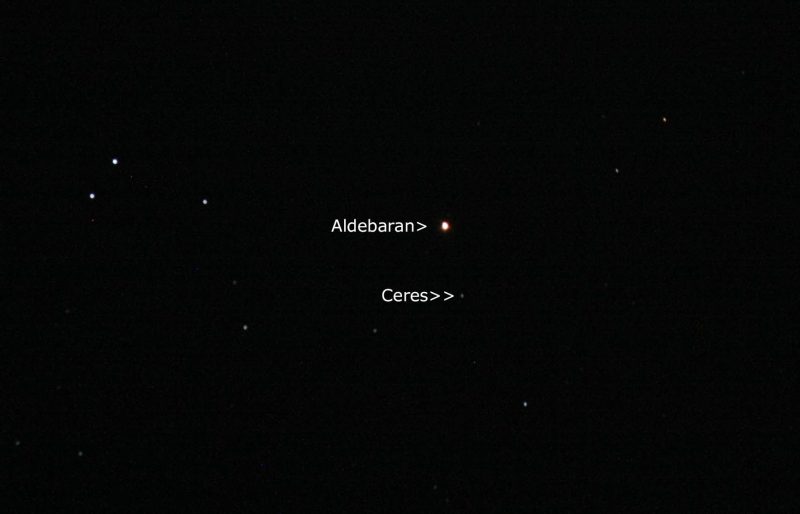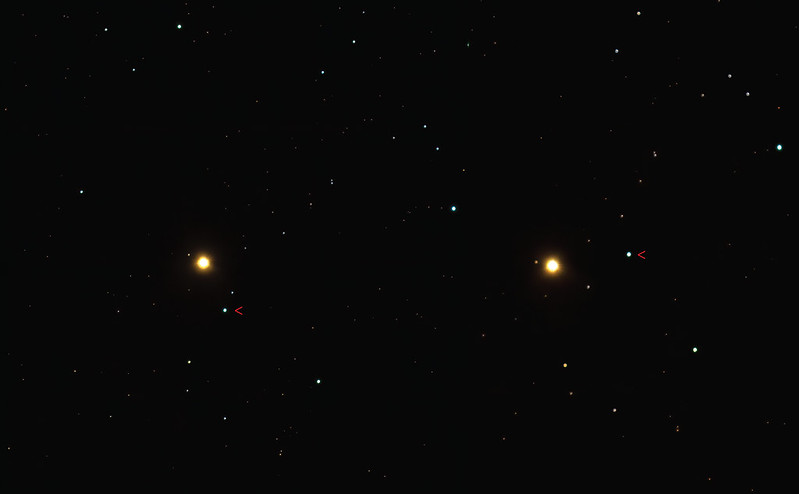
Tiny Ceres, mighty Aldebaran
Dwarf planet Ceres – largest body in the asteroid belt between Mars and Jupiter – and giant star Aldebaran are meeting up in the sky in early November 2021. Aldebaran is the brightest star in Taurus the Bull. It’s 65 light-years away. But it’s huge, some 40 times our sun’s diameter. Meanwhile, Ceres is just a little ball of rock, only about 300 miles (500 km) across. So Aldebaran shines as one of our sky’s brightest stars. And Ceres shines at the limit of visibility to the unaided eye. Yet Ceres’ sweep past Aldebaran this month drew the attention of earthly astrophotographers.
The photographers captured Ceres by looking at Aldebaran over multiple nights and noticing which nearby “star” moved in relationship to Aldebaran. That point of light is Ceres, which appears to move because it’s so much closer to us than Aldebaran. As you can see from the photos on this page – several of which show several different nights of observation – Ceres is moving. So it’s noticeable, although it’s only a dim dot compared to blazing Aldebaran.
Ceres has been been drifting through the constellation Taurus for some weeks. And some photographer friends of EarthSky caught it as it passed Aldebaran, which marks the Bull’s eye and is part of the V-shaped Hyades cluster that forms the Bull’s face..
Ceres will reach opposition on November 27, when it’ll be opposite the sun in our sky and visible all night long. It will also be as close as it comes to Earth for 2021 around the time of opposition. So it’s now at about its brightest for this year and will remain so throughout November and into early December.
The 2022 lunar calendars are here. Order yours before they’re gone!
Photos of Ceres and Aldebaran


Bottom line: Ceres and Aldebaran came close together as seen from Earth in early November, and EarthSky community members were ready to capture the moment.
The post Ceres and Aldebaran met in early November 2021 first appeared on EarthSky.
from EarthSky https://ift.tt/3o3sWrM

Tiny Ceres, mighty Aldebaran
Dwarf planet Ceres – largest body in the asteroid belt between Mars and Jupiter – and giant star Aldebaran are meeting up in the sky in early November 2021. Aldebaran is the brightest star in Taurus the Bull. It’s 65 light-years away. But it’s huge, some 40 times our sun’s diameter. Meanwhile, Ceres is just a little ball of rock, only about 300 miles (500 km) across. So Aldebaran shines as one of our sky’s brightest stars. And Ceres shines at the limit of visibility to the unaided eye. Yet Ceres’ sweep past Aldebaran this month drew the attention of earthly astrophotographers.
The photographers captured Ceres by looking at Aldebaran over multiple nights and noticing which nearby “star” moved in relationship to Aldebaran. That point of light is Ceres, which appears to move because it’s so much closer to us than Aldebaran. As you can see from the photos on this page – several of which show several different nights of observation – Ceres is moving. So it’s noticeable, although it’s only a dim dot compared to blazing Aldebaran.
Ceres has been been drifting through the constellation Taurus for some weeks. And some photographer friends of EarthSky caught it as it passed Aldebaran, which marks the Bull’s eye and is part of the V-shaped Hyades cluster that forms the Bull’s face..
Ceres will reach opposition on November 27, when it’ll be opposite the sun in our sky and visible all night long. It will also be as close as it comes to Earth for 2021 around the time of opposition. So it’s now at about its brightest for this year and will remain so throughout November and into early December.
The 2022 lunar calendars are here. Order yours before they’re gone!
Photos of Ceres and Aldebaran


Bottom line: Ceres and Aldebaran came close together as seen from Earth in early November, and EarthSky community members were ready to capture the moment.
The post Ceres and Aldebaran met in early November 2021 first appeared on EarthSky.
from EarthSky https://ift.tt/3o3sWrM

Aucun commentaire:
Enregistrer un commentaire